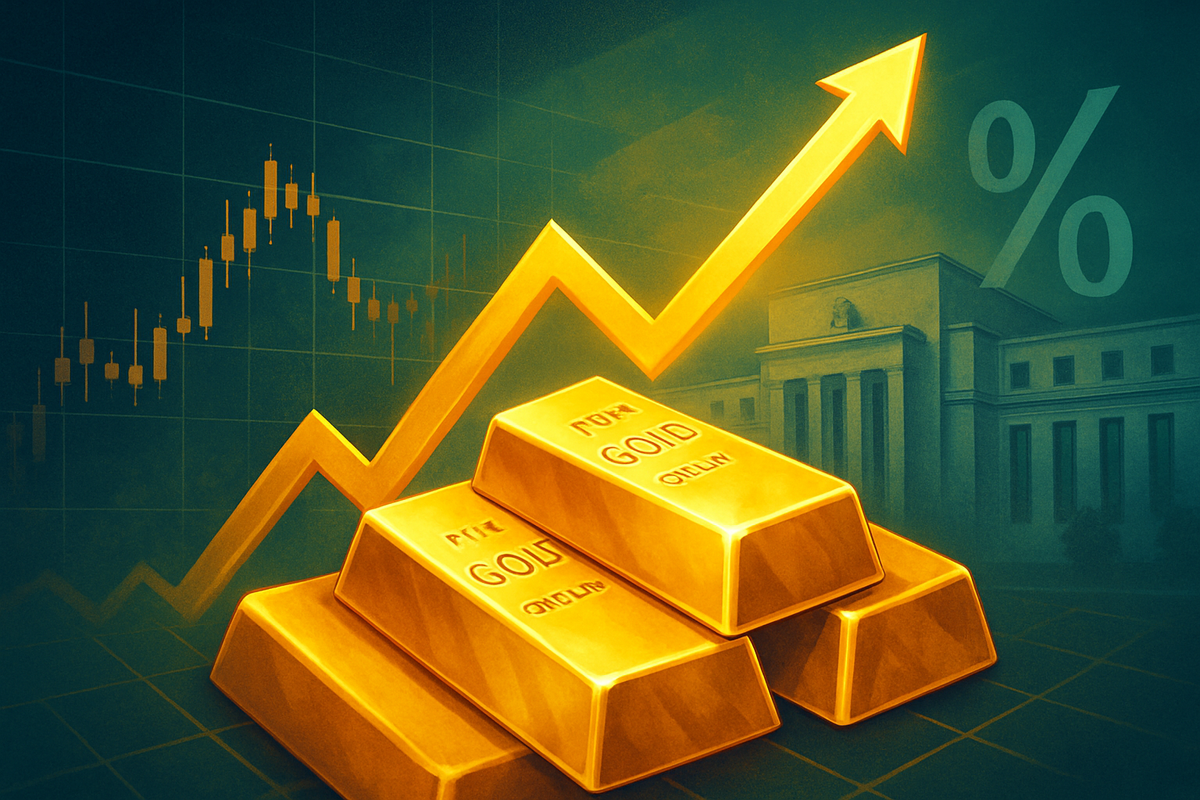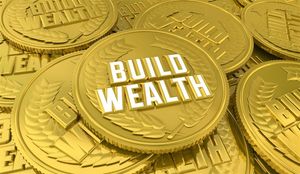
Gold prices have recently shattered all previous records, surging to unprecedented levels as market participants increasingly anticipate a series of interest rate cuts from the Federal Reserve. This remarkable rally, pushing gold above $3,900 per ounce by October 2025, underscores a significant shift in investor sentiment, as the precious metal reasserts its role as a premier safe-haven asset amidst evolving economic landscapes and geopolitical uncertainties.
The expectation of lower interest rates fundamentally alters the investment calculus for gold, a non-yielding asset. As the opportunity cost of holding gold diminishes relative to interest-bearing alternatives, and a weaker U.S. dollar makes the commodity more attractive internationally, investors are flocking to gold as a hedge against potential inflation and market volatility. This strategic pivot highlights a growing anxiety within financial markets, signaling a re-evaluation of traditional asset classes and a renewed confidence in gold's enduring value.
The Golden Rush: A Detailed Account of the Price Surge
The ascent of gold to record-breaking valuations has been a defining narrative in financial markets throughout 2024 and 2025. The precious metal has consistently broken through psychological and technical barriers, with its price climbing steadily to surpass the $3,900 per ounce mark by October 2025. This historic run is largely attributed to a pivotal shift in the Federal Reserve's monetary policy, moving from an aggressive tightening cycle to an anticipated easing phase.
The timeline leading to this golden surge began with the Federal Reserve's robust campaign of interest rate hikes throughout 2022 and 2023, aimed at taming persistent inflation. However, as inflation showed signs of moderating and economic growth faced headwinds, the Fed initiated its first rate cut of 25 basis points in September 2025, setting the federal funds rate to a target range of 4.0%-4.25%. This singular move ignited market speculation, with a high probability now priced in for further 25 basis point reductions in both October and December 2025. Projections from major financial institutions, including J.P. Morgan (NYSE: JPM) and Morningstar (NASDAQ: MORN), suggest a sustained period of rate cuts extending into 2026 and 2027, potentially bringing the federal funds rate down significantly.
Key players in this unfolding drama include the Federal Reserve, whose policy decisions are the primary catalyst; global investors, who are actively reallocating capital into gold; and central banks worldwide, which have been aggressively increasing their gold reserves as a strategic diversification away from dollar-denominated assets. The gold mining industry is also a significant stakeholder, benefiting immensely from the elevated prices. Initial market reactions have been overwhelmingly positive for gold-related assets, though consumers in markets like the UAE are facing higher costs for gold products. The sustained climb reflects a deeper market anxiety, suggesting a potential paradigm shift in global finance and investment strategies.
Corporate Fortunes in the Golden Glow: Winners and Losers
The unprecedented surge in gold prices presents a clear dichotomy for public companies, creating significant winners within the mining and precious metals sectors, while posing challenges for industries sensitive to commodity price inflation or shifting consumer spending. Understanding these dynamics is crucial for investors navigating the current market environment.
Gold mining companies stand as the most direct beneficiaries of this rally. Major producers like Barrick Gold Corporation (NYSE: GOLD), Newmont Corporation (NYSE: NEM), and Agnico Eagle Mines Limited (NYSE: AEM) are experiencing substantially enhanced profitability. Higher gold prices translate directly into increased revenues and robust cash flows, allowing these companies to boost exploration budgets, expand existing operations, or return capital to shareholders through dividends and buybacks. Junior mining companies, often with higher production costs, also find newfound viability for projects that were previously marginal, potentially leading to increased mergers and acquisitions activity within the sector.
Conversely, companies heavily reliant on gold as a raw material, such as jewelry manufacturers and certain electronics producers, face rising input costs. While luxury jewelers like Tiffany & Co. (owned by LVMH Moët Hennessy Louis Vuitton, EPA: MC) might be able to pass on some of these costs to affluent consumers, mass-market jewelers could see squeezed margins or a decline in demand as gold products become more expensive. Retailers specializing in gold coins or bullion may also see increased sales volume, but their profit margins are typically tied to premiums over spot price, which might fluctuate. Financial institutions with significant exposure to commodity trading or those offering gold-backed investment products could see increased activity and revenue, though volatility always presents risks.
The broader economic implications of sustained high gold prices, especially if driven by persistent inflation concerns, could also affect companies across various sectors. For instance, if the underlying reason for rate cuts is a weakening economic outlook, then consumer discretionary companies or those sensitive to economic cycles might face headwinds, even as gold thrives. Furthermore, companies in emerging markets that are large gold consumers, such as India and China, might see shifts in consumer behavior impacting local industries.
Beyond the Glitter: Wider Significance and Market Repercussions
The current gold rally is more than just a fleeting market event; it represents a significant chapter in broader industry trends and carries profound implications for global financial architecture. This surge fits squarely into a pattern of increasing demand for tangible assets in an era marked by economic uncertainty, geopolitical instability, and a fundamental questioning of traditional monetary policies.
One of the most significant trends is the aggressive accumulation of gold by central banks globally. This is not merely a diversification strategy but a strategic pivot away from dollar-denominated assets, signaling a desire to reduce dependency on currencies perceived as vulnerable to geopolitical disputes or policy shifts. This sustained institutional demand provides a robust floor for gold prices, insulating them from some of the volatility seen in purely speculative retail trading. The ripple effects extend to international trade and currency markets, potentially accelerating the de-dollarization trend and fostering a more multipolar financial system.
Regulatory and policy implications are also at play. As central banks worldwide re-evaluate their reserve compositions, there could be increased scrutiny on the transparency and liquidity of gold markets. Furthermore, if gold's role as an inflation hedge becomes even more pronounced, policymakers might face renewed pressure to address underlying inflationary pressures more effectively. Historically, gold has surged during periods of high inflation or economic crisis, such as the 1970s oil shocks or the 2008 financial crisis, serving as a barometer of market confidence in the existing financial order. The current environment, with its blend of inflation concerns, geopolitical tensions, and anticipated monetary easing, draws parallels to these historical precedents, reinforcing gold's enduring appeal.
The rally also highlights a growing investor skepticism towards traditional financial assets and the efficacy of central bank policies. While rate cuts are typically aimed at stimulating economic growth, the concurrent rise in gold prices suggests that many investors view these cuts as a response to underlying economic vulnerabilities or as a precursor to future inflation, rather than a sign of robust recovery. This sentiment could drive further capital reallocation into alternative assets, potentially impacting equity and bond markets.
The Road Ahead: Navigating the Golden Future
The trajectory of gold prices in the coming months and years will largely hinge on the Federal Reserve's actual rate-cutting cycle and the broader global economic and geopolitical landscape. In the short term, continued rate cuts, as widely anticipated, are likely to provide further impetus for gold's upward momentum. Each reduction in interest rates diminishes the opportunity cost of holding gold and could weaken the U.S. dollar, making gold more attractive to international buyers.
However, potential strategic pivots or adaptations are required for investors and companies alike. If inflation proves more persistent than anticipated, or if global economic growth surprises on the upside, the Fed might slow or even reverse its rate-cutting path, which could introduce volatility into the gold market. Conversely, an escalation of geopolitical tensions or a deeper global economic downturn would likely reinforce gold's safe-haven appeal, pushing prices even higher. Market opportunities may emerge in gold-backed exchange-traded funds (ETFs), gold mining stocks, and even physical gold bullion, as investors seek to capitalize on the ongoing trend.
In the long term, the structural shift by central banks to diversify reserves away from fiat currencies, particularly the U.S. dollar, is a powerful underlying driver for sustained gold demand. This trend, coupled with ongoing global uncertainties, suggests that gold could maintain a higher price floor than in previous cycles. Potential scenarios range from a continued steady climb, supported by gradual rate cuts and persistent inflation concerns, to more dramatic spikes if a significant financial crisis or geopolitical event unfolds. Conversely, a rapid and sustained global economic recovery, coupled with aggressive inflation control, could temper gold's appeal.
Companies in the gold sector will need to strategically manage their capital allocation, balancing exploration and expansion with shareholder returns. For consumers, the expectation of high gold prices could lead to continued shifts in purchasing habits towards lighter or less elaborate gold items, or increased interest in gold as an investment rather than purely for adornment.
Golden Horizon: A Comprehensive Wrap-Up
The recent surge in gold prices to record highs, predominantly driven by market expectations of Federal Reserve interest rate cuts, marks a pivotal moment in financial markets. Key takeaways include gold's re-establishment as a primary safe-haven asset, the significant impact of monetary policy on non-yielding assets, and a growing global trend of diversification away from traditional fiat currencies by central banks. This rally is not merely speculative but reflects deep-seated anxieties about inflation, economic stability, and geopolitical risks.
Moving forward, the market will be closely watching the Federal Reserve's next moves. The anticipated sequence of rate cuts is expected to continue providing tailwinds for gold, reinforcing its attractiveness as the opportunity cost of holding it decreases and the U.S. dollar potentially weakens. This environment creates both opportunities and challenges across various sectors, particularly for gold mining companies which stand to benefit immensely, and for consumers who face higher prices for gold products.
The lasting impact of this event could be a fundamental re-calibration of investment strategies worldwide, with gold playing an even more central role in diversified portfolios. Investors should watch for further announcements from the Federal Reserve regarding interest rates, geopolitical developments, and inflation data. The actions of central banks in their gold accumulation efforts will also provide critical insights into the long-term demand dynamics for the precious metal. The golden horizon appears bright, but vigilance remains key in a volatile global economy.
This content is intended for informational purposes only and is not financial advice.





